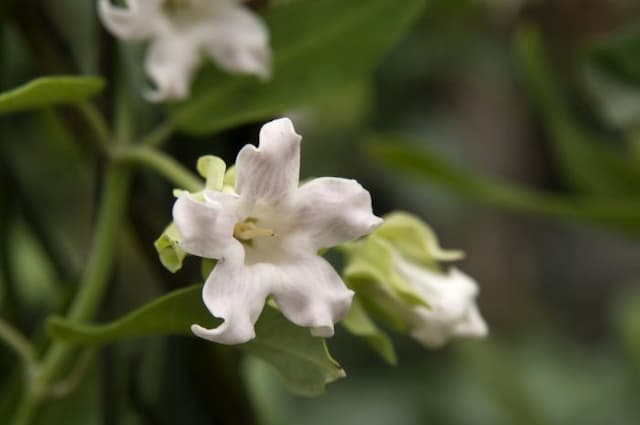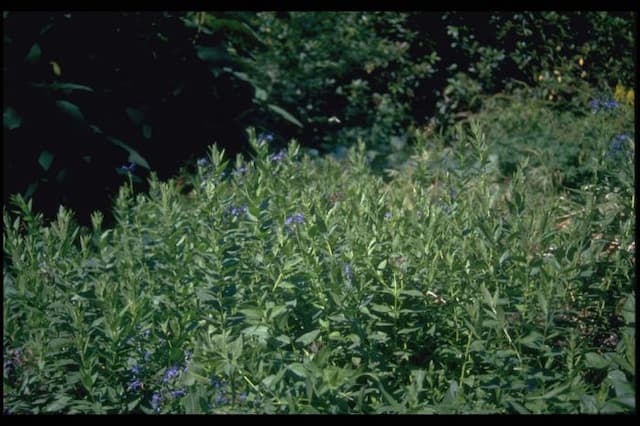Arkansas Blue Star Amsonia hubrichtii

ABOUT
Amsonia hubrichtii, commonly known as threadleaf bluestar, is a perennial plant that is particularly noted for its feathery, soft, needle-like leaves. These leaves are light green in color and create a fine-textured bushy mound, giving the plant a delicate and airy appearance. In spring, the threadleaf bluestar blooms with clusters of small, star-shaped flowers that are a soft powder blue, adding a subtle but striking burst of color. The flowering display can be quite impressive, attracting various pollinators to the garden. As the seasons change, this plant provides continued visual interest; in the fall, the foliage of the threadleaf bluestar turns a golden yellow, painting a striking contrast against the autumn landscape. The overall impression of Amsonia hubrichtii is one of a graceful and elegant plant that imparts a soft texture to garden settings.
About this plant
 Names
NamesFamily
Apocynaceae
Synonyms
Arkansas Blue Star, Hubricht's Amsonia, Thread-leaf Blue Star, Narrow-leaf Blue Star
Common names
Amsonia hubrichtii
 Toxicity
ToxicityTo humans
Amsonia hubrichtii, commonly known as the Arkansas blue star, is not widely recognized as a poisonous plant to humans. There are no well-documented cases of toxicity or symptoms related to the ingestion or contact with Arkansas blue star. However, as with any plant, individual allergic reactions or sensitivities could occur, so it is generally advisable to avoid ingesting plants that are not specifically intended for human consumption.
To pets
Arkansas blue star is not typically known to be toxic to pets. There are no significant reports of poisoning in domestic animals from the consumption or contact with Amsonia hubrichtii. However, pet owners should still prevent pets from ingesting the plant as a precautionary measure because individual animals might have different sensitivities or allergic reactions to plants that are not part of their normal diet.
 Characteristics
CharacteristicsLife cycle
Perennials
Foliage type
Deciduous
Color of leaves
Green
Flower color
Blue
Height
3 feet (0.91 meters)
Spread
3 feet (0.91 meters)
Plant type
Shrub
Hardiness zones
5
Native area
North America
Benefits
 General Benefits
General Benefits- Ornamental Value: Amsonia hubrichtii, also known as the Arkansas blue star, has attractive feathery foliage and delicate blue flowers that add beauty to gardens.
- Seasonal Interest: The plant features a dramatic seasonal transition with bright green leaves in spring and summer, which turn to a stunning golden yellow in the fall.
- Drought Tolerance: Arkansas blue star is well-suited for xeriscaping as it is drought-resistant once established, making it ideal for low-water gardens.
- Wildlife Attraction: The flowers attract pollinators such as butterflies and bees, supporting local ecosystems.
- Low Maintenance: This plant requires minimal care, making it ideal for gardeners who prefer a low-maintenance landscape.
- Deer Resistance: The Arkansas blue star is generally resistant to deer, which helps to prevent damage in gardens where deer might be a problem.
- Naturalizing: It can spread and naturalize in optimum growing conditions, filling out garden spaces and providing a coherent look.
 Medical Properties
Medical PropertiesThis plant is not used for medical purposes.
 Air-purifying Qualities
Air-purifying QualitiesThis plant is not specifically known for air purifying qualities.
 Other Uses
Other Uses- Amsonia hubrichtii, commonly known as the threadleaf bluestar, can be used in cut flower arrangements due to its feathery foliage and starry flowers, providing a delicate texture to bouquets.
- The threadleaf bluestar's dried seed pods can be used for crafting, as they add an interesting shape and texture to dried floral arrangements and wreaths.
- In garden design, threadleaf bluestar can function as a natural fence when planted in a row due to its upright and clumping growth habit.
- The plant is beneficial for erosion control on slopes or banks because its roots help stabilize the soil and prevent the washing away of topsoil during heavy rains.
- Threadleaf bluestar can be used as a backdrop plant in perennial borders because it grows tall and has attractive foliage that complements flowering plants in the foreground.
- The foliage of threadleaf bluestar turns a striking golden-yellow in the fall, making it useful for adding seasonal interest to gardens and landscapes.
- Threadleaf bluestar can serve as a host plant for the larvae of certain butterflies, thereby supporting local biodiversity and butterfly populations in gardens.
- This plant may be used in xeriscaping, which is a landscaping method that reduces or eliminates the need for supplemental water from irrigation, due to its drought tolerance once established.
- When used in mass plantings, threadleaf bluestar can provide a sense of movement with its grass-like foliage reacting to wind, creating a dynamic visual effect.
- The threadleaf bluestar is suitable for planting in rain gardens where its roots can help absorb excess runoff water and mitigate flooding issues.
Interesting Facts
 Feng Shui
Feng ShuiThe Blue Star is not used in Feng Shui practice.
 Zodiac Sign Compitability
Zodiac Sign CompitabilityThe Blue Star is not used in astrology practice.
 Plant Symbolism
Plant Symbolism- Persistence: Amsonia hubrichtii, commonly known as the Arkansas blue star, exhibits resilience and persistence through its ability to thrive in a variety of conditions and its long-lasting blooms.
- Patience: The Arkansas blue star represents patience, as the plant takes time to establish itself before it flourishes and shows its full beauty in the landscape.
- Peace: With its soft blue-colored flowers and feathery foliage, the Arkansas blue star often symbolizes tranquility and peace.
- Adaptability: Native to North America, this plant symbolizes adaptability due to its ability to survive in different habitats and the changing seasons.
 Water
WaterThreadleaf bluestar prefers consistent moisture, especially during its first growing season to establish a deep, extensive root system. Once established, it is more drought tolerant and should be watered deeply but infrequently. Aim to water the plant with about 1 inch of water per week, adjusting for rainfall. During hot, dry periods, increase watering to every few days to maintain soil moisture, while in cooler, wetter seasons, reduce the frequency. Always allow the soil to dry out slightly between watering sessions to prevent root rot.
 Light
LightThreadleaf bluestar thrives in full sun, meaning it requires at least 6 hours of direct sunlight daily. However, it can also tolerate partial shade, especially in hot climates where some afternoon protection from intense sun can be beneficial. The ideal spot for this plant is an area that receives bright sunlight for most of the day with some light, dappled shade in the afternoon.
 Temperature
TemperatureThreadleaf bluestar is hardy and can tolerate a wide range of temperatures, from about -20 to 90 degrees Fahrenheit. This resilience makes it well-suited for many garden environments, but it prefers moderate conditions and performs best in temperatures that are not extreme. While the plant is winter hardy, it's important to avoid exposed, excessively windy locations that can damage the foliage in the winter.
 Pruning
PruningPrune Threadleaf bluestar to maintain its shape and encourage bushier growth. Cut back the foliage in late winter or early spring before new growth starts. This plant benefits from being cut back to about 3-4 inches above the ground to promote fresh, strong stems and a more compact habit. Additionally, deadheading the spent flowers in summer can sometimes encourage a second bloom.
 Cleaning
CleaningAs needed
 Soil
SoilThreadleaf bluestar thrives best in a well-draining soil mix with added organic matter like compost, preferably having a slightly acidic to neutral pH range of 6.0 to 7.0.
 Repotting
RepottingThreadleaf bluestar does not require frequent repotting and can be repotted every 3 to 4 years or as necessary to refresh the soil.
 Humidity & Misting
Humidity & MistingThreadleaf bluestar tolerates a wide range of humidity levels and does not have specific humidity requirements, making it adaptable to various outdoor conditions.
 Suitable locations
Suitable locationsIndoor
Ensure bright light, cool winter temps, and well-draining soil for indoor growth.
Outdoor
Plant in full sun to part shade, in well-drained soil, hardy and low maintenance.
Hardiness zone
4-9 USDA
 Life cycle
Life cycleAmsonia hubrichtii, commonly known as Threadleaf bluestar, begins its life cycle as a seed, which after dispersal in late fall, will overwinter and germinate in the spring. The seedlings establish a deep root system before their above-ground growth begins to flourish. The juvenile stage is characterized by the development of its distinctive narrow, needle-like leaves and a bushy habit. As it matures, typically by the second or third year, the perennial enters the flowering stage in late spring, producing starry, pale blue blossoms that attract pollinators. After flowering, the plant sets seed in late summer to early fall, and the foliage transforms into a striking golden color in the autumn. The plant then enters a period of dormancy during winter, dropping its leaves and conserving energy for the subsequent growing season.
 Propogation
PropogationPropogation time
Spring - Summer
Amsonia hubrichtii, also known as threadleaf bluestar, is commonly propagated by seed or division. The most popular method of propagation for this plant is by division, which is ideally performed in the early spring or fall. To propagate threadleaf bluestar by division, carefully excavate the plant from the ground, ensuring a substantial amount of the root system is intact. Using a sharp spade or knife, divide the clump into smaller sections, each with several shoots and a portion of the root system. Replant the divisions promptly at the same depth they were originally growing, spacing them about 18 inches (approximately 45 centimeters) apart to allow for mature spread. Water the new plants thoroughly after replanting to help establish them in their new locations.









